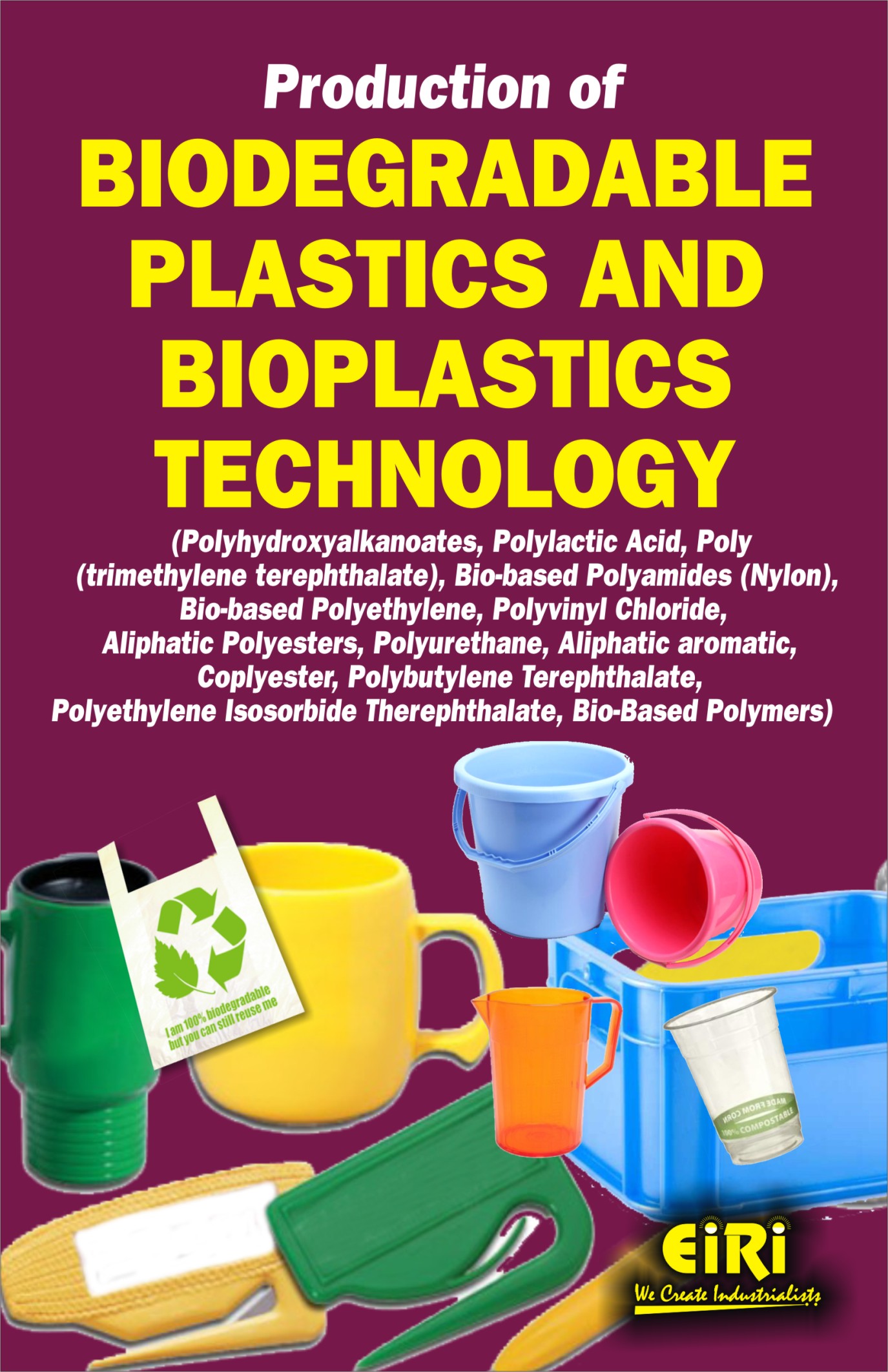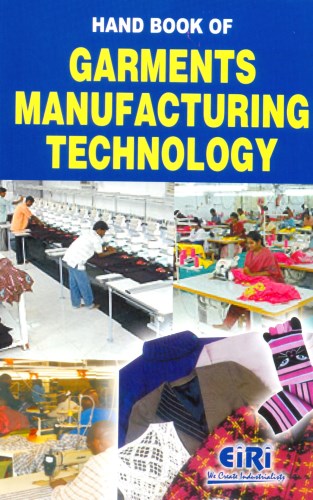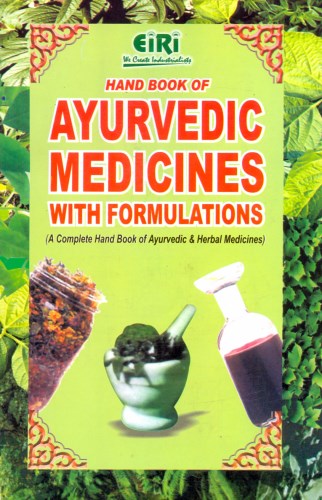Description
The book covers Manufacturing Polyhydroxyalkanoates (a Biodegradable Polymer), Methods, Extraction and Analysis of Polyhydroxyalkanoate (PHA) from Bacterial Isolates, Bacterially Manufactured Polyhydroxyalkanoate (PHA) Converting Renewable Resources into Bioplastics, Polyhydroxyalkanoates(PHA) Production, Polyhydroxy Alkanoates A Sustainable Alternative to Petro Based Plastics, Industrial Demand of Polyhydroxyalkanoate Bioplastic, Applications of Polyhydroxyalkanoates in the Medical Industry, Production of Polylactic Acid (PLA) and Conversion Technology, Technology of Biodegradable Plastic (Poly Lactic Acid) from Molasses, Biodegradable Poly Lactic Acid Plastics produced by Injection Moulding, Crystalline Structure of Annealed Polylactic Acid and its processing, Manufacturing Process of PLA based Composites Reinforced with Cellulose Fibers & Fibrils, Poly(trimethylene terephthalate) (PTT), Bio based Polyamides (Nylon), Production Technology of Bio based Polyethylene Manufacturing and Properties of Polyvinyl Chloride (PVC) from Bio-based PE, Polyurethane(PUR) from Bio based Polyols, Thermosets (Bio-based), Other Bio based Thermoplastics, Biodegradation of Aliphatic aromatic Coplyester, Synthesis and Characterizations of Degradable Aliphatic Aromatic Coplyesters, Degradation of Aliphatic Polyesters, Biodegradable Polymer Networks ( Aliphatic Polyesters), Biodegradable Polyesters for Medical and Ecological Applications, Polybutylene Terephthalate (PBT) from Bio based BDO, Poly(butylenes succinate) (PBS) from Biobased Succinic Acid, Bio based Polyethylene Terephthalate (PET) Polyethylene Isosorbide Therephthalate (PEIT), Applications of Bio based Polymers, Current and Projected Demand for Bio based Polymers.
PRODUCTION OF BIODEGRADABLE PLASTICS AND BIOPLASTICS TECHNOLOGY
(Polyhydroxyalkanoates, Polylactic Acid, Poly(trimethylene terephthalate), Bio-based Polyamides (Nylon), Bio-based Polyamides (Nylon), Bio-based Polyethylene, Polyvinyl Chloride, Aliphatic Polyesters, Polyurethane, Aliphatic aromatic, Copolyester, Polybutylene Terephthalate, Polyethylene Isosorbie Therephthalate, Bio-Based Polymers)
MANUFACTURING POLYHYDROXYALKANOATES (A BIODEGRADABLE POLYMER)
- Biosynthetic Pathways of PHA
- The general structure of polyhydroxyalkanoates
- The biosynthetic pathway of PHB and P(HB-HV) in Alcaligenes eutrophus
- Polyhydroxyalkanoates as biodegrable thermoplastic
- Physical properties of various PHAs and polypropylene
- Production of Polymer
- The polymer biodegradability
METHODS, EXTRACTION AND ANALYSIS OF POLYHYDROXYALKANOATE (PHA) FROM BACTERIAL ISOLATES
- Materials and Methods
- Collection of organism and subculturing
- Screening of microorganisms
- Mineral media preparation
- Growth rate studies of organisms
- Microscopic observation
- N2 estimation and extraction
- Estimation of nitrogen
- Screening of substrate
- Effect of carbon source
- Standard nitrogen curve
- Clumps of Pseudomonas aeruginosa
- Percentage PHA yield by P.aeruginosa
- P.aeruginosa organism
- Bacillus subtills
- clumps of Bacillus subtills
- Percentage PHA yield by Bacillus subtills
- Results and Disccussion
- Percentage PHA yield by increase in substrate with combination of sugarcane bagasse with P.aeruginosa Carbon
- Standard nitrogen table
- Brief Conclusion
BACTERIALLY MANUFACTURED POLYHYDROXYALKANOATE (PHA) CONVERTING RENEWABLE RESOURCES INTO BIOPLASTICS
- Development of polyhydroxyalkanoate (PHA) and its importance
- Development of PHA
- Bacterial used for production of PHA from plant oils and wastes
- Biosynthesis of PHA
- Bacterial Strains
- Fermentation processes
- Development of renewable resources
- Plant oils
- Observation of PHA granules under phasecontrast and transmission electronmicroscope
- Glycerol
- Carbon dioxide
- Other attractive renewable resources
- Downstream processing (PHA recovery and purification)
- Applications of PHA
- Conclusion
POLYHYDROXYALKANOATES (PHA) Production
- PHAs Production from Molasses
- PHAs Production from whey and whey hydrolysates
- PHAs fermentations using various cheap substrates
- PHAs Production from lignocellulosic raw materials
- PHA Production from fats, vegetable oils and cooking oils
- PHAs Production from glycerol
- PHAs Production from wastewater
- Material properties of PHAs Produced from different carbon sources
- Physical properties of some PHAs and synthetic plastic commoditiesa
- Conclusions and Results
POLYHYDROXY ALKANOATES A SUSTAINABLE ALTERNATIVE TO PETRO BASED PLASTICS
- Biopolymer
- Classification of PHAs Comparison between Biopolymer and Petrobased plastics
- Characteristics of Polyhydroxyalkanoates
- Physical characteristics
- Biological characteristics
- A comparison between the physical properties of different PHAs and commonly used conventional polymers
- Synthetic Biology, Bioplastics and Environment
- Biodegradability
- Biocompatibility
- Renewable nature
- Sustainable PHAs Using Low Cost Production Technology
- Microorganisms
- Waste materials as inexpensive substrate
- Plant oils
- Rice bran
- Molasses
- Dairy whey
- Downstream processing
- Conclusions
INDUSTRIAL DEMAND OF POLYHYDROXYALKANOATE BIOPLASTIC
- Fossil Fuels
- Petroleum
- A hydrocarbon unit, and common hydrocarbons Methane Ethane, Octane
- Plastics
- Petroleum lastics
- Major products of naphtha cracking
- A simplified polymerization reaction of ethylene molecules to produce a polymer, where in is the number of subunits defined by reaction conditions
- Bioplastics
- Polhydroxyalkanoate (PHA)
- PHA Structure, Function and Mechanism
- Polhydroxyalkanoate (PHA) Polyhydroxybutyrate (PHB) An ester n is number of subunits, n is number of carbons within subunit, R and R are alkyl groups
- PHA Sources, Biosynthesis, and Degradation
- Health, Environmental and Industrial Implications
- Future Demand
- Conclusion
APPLICATIONS OF POLYHYDROXYALKANOATES IN THE MEDICAL INDUSTRY
- Schematic structures of representative polyhydroxyalkanoates
- Biocompatibility of polyhydroxyalkanoates
- Biocompatibility of plyhydroxyalkanoates
- Examples of PHA matrices fabricated for medical use
- Survey of in Vivo Biocompatibility Studies of PHA Matrices
- Polyhydroxyalkanoates as medical scaffolding material
- Polyhydroxyalkanoates as surgical material
- Drug release
- Survey of Drug Release Studies from PHA Matrics
- Medical polyhydroxyalkanoaes
PRODUCTION OF POLYLACTIC ACID (PLA) AND CONVERSION TECHNOLOGY
- PLA molecule
- Production of PLA
- Lactic acid from a carbon substrate
- PLA from lactic acid
- Production of PLA from fermentable sugar
- Stereocomplexation between PLLA and PDLA
- Stereocomplexation
- Crystal structure of PLA Stereocomplex
- Conversion technologies
- Properites
- PLA family copolymers of D and L Lactic units
- Chemical Properties
- Properties of NatureWorks PLA Polymers
- Physical Properties
- Thermal properties of amorphous versus crystalline and stereocomplex PLA
- Mechanical Properties
- Thermal Properties
- Other properties
- Thermal properties of amorphous versus crystalline and stereocomplex PLA
- Main applications for PLA share of interviewed companies, total production by market sector.
- Properties of copolymers, blends and composities
- Additives
- Technical substitution potential
- Applications today and tomorrow
- Sector
TECHNOLOGY OF BIODEGRADABLE PLASTIC (POLY LACTIC ACID) FROM MOLASSES
- Material and methods
- Experiments
- Lactic acid production
- Block Diagram fr production of PLA
- Procedure
- Result
- Observations
- Properties of lactic acid
- PLA Production Procedure
- Result
- Observation
- Major Engineering Problems
- Comparative analysis of Poly lactic acid
- Conclusion
- Washing of PLa with Methanol
- Conclusion
BIODEGRADABLE POYLACTIC ACID PLASTICS PRODUCED BY INJECTION MOULDING
- Characteristics of material
- Molecular structure of polylactide
- Polymerization route to polylactide & Schematic of PLA
- Produced via prepolymer and lactide
- Methods processing of Poly lactic acid (PLA)
- Injection Moulding
- Major components of an injection molding machine showing the extruder (reciprocal screw) and clamp units
- Results
CRYSTALLINE STRUCTURE OF ANNEALED POLYLACTIC ACID AND ITS PROCESSING
- Materials, processing and experimental
- Results and discussion
- WAXD spectra of PLA annealed at 80oC for 10-60 minutes
- WAXD spectra of PLA annealed at 120oC for 10-60 minutes
- (a) DMA and (b) DSC curves of un annealed, amorphous PLA captured at a 1oC/min heating rate
- DMA curves of un annealted PLA captured at 1-2-5-10 15-20oC/min heating rates
- DSC curves of un annealed PLA captured at (a) 10 and (b) 20oC/min heating rates
- Crystallization enthalpies and enthalpies of fusion of the unannealed specimens
- DMA curves of annealed PLA
- The DMA curve of amorphous, semi crystalline, and recrystallized PLA
- Crystallinity values, crystallization enthalpies and enthalpies of fusion of the annealed specimens
- The DMA curves for amorphous PLA semi crystalline PLA, and PLA recrystallizing during measurement
- DSC curves of PLA annealed at 80oC
- The amorphous PLA pellets stuck on the sruface of the screw
- Welded surface of pellets at 80oC
- Unannealed and annealed pellet with peeled off ribbons
- Peeled off ribbons on the srface of PLA pellet
- DSC curves of (a) annealed and (b) unannealed PLA/starch blends
- Conclusions
MANUFACTURING PROCESS OF PLA-BASED COMPOSITES REINFORCED WITH CELLULOSE FIBERS & FIBRILS
- The reduction of plastic waste a future challenge
- Composites produced from a sustainable feedstock a possible solution
- Background
- Pulp and pulping different approaches
- Kraft Process
- Schopper Riegler concept
- Cellulose structure and morphology
- MFC produced from wood based materials now and then
- Crystal unit cell of five cellulose chains with the dimension of 8x8x80A
- Hierarchical structure of a wood from a cellulose molecule to a cellulose fiber
- Pre treatments
- Enzymatic treatment
- Polylactic acid
- Cellulose fibrils aggregate to form larger bundles of fibers creating a hierarchical structure
- Repeating unit of PLA
- Previous and planned production of biodegradable plastics in metric tons
- Basic concept of composites
- Plastic based composites with MFC and cellulose fibers as reinforcing agents
- Different dimensions and orientation of the reinforcing fibers in a composite
- Scientific space from literature study
- Method and materials
- Experimental setup and manufacturing of composites with a sheet former
- Materials
- Wet step
- Drying step
- Melting step
- A standard sheet former
- The two layers formed through the two step approach
- Results
- Influence of methodology
- PLA/MFC composites made by pre drying in Buchher funnel
- Formette method
- Fibers impregnated with alkyl ketene (AKD) without bottom layer
- MFC reinforced HRKP/PLA composites with a bottom layer
- SEM images
- HRKP reinforced composites with a bottom layer before & after not pressing
- SEM images
- HRKP reinforced composites with a bottom layer before & after hot pressing
- 50/50 HRKP/PLA sample with a pure 20 gm2 HRKP bottom layer not yet hot pressed
- Magnified (2000x) of a 50/50 HRKP/PLA sample not yet hot pressed
- Hot pressed 50/50 HRKP/PLA composites Mag 500x
- Kraft pulp reinforced composites and pure kraft pjp film
- HRKP reinforced composites with small additions of MFC
- Magnification (2000000x) of a hot pressed 50/50 HRKP/PLA sample
- 50/50 Kraft pulp/PLA composite, Dispersion is limited between the two species, Magnification 992x
- Sample of pure kraft pulp with A) fiber aggregation and B) w\void/defects Magnification 554xX
- MFC reinforced 40/60 HRKP/PLA composites
- Mechanical testing
- HRKP/PLA composites with varying pulp content and relative bottom layer thickness
- PLA Composites with constant bottom layer containing refined pulps HRKP and MFC
- PLA composites with a constant bottom layer containing less refined pulps kraft pulp CTMP and broke
- MFC reinforced HRKP/PLA composites
- Discussion
- Tensile strength for PLA composites reinforced with varying amounts of HRKP
- Strain plotted against increasing HRKP content
- Since 50% of the total HRKP content was added as a bottom layer the grammage increased relative to total amount of pulp present in the composite
- Stress strain curves of HRKP/PLA composites 100/0 in red. 70/30 green & 30/70 blue
- Tensile strength for HRKP/PLA composites with constant bottom layer plotted against increaseing HRKP content
- Comparison of tensile strength of HRKP and MFC composites with increasing pulp content
- Comparson of tensile strength of BSKP, CTMP and broke composites with increasing pulp content
- Tensile strength of 50/50 HRKP/PLA composites reinforced with 0.2, 4.6 and 8% MFC
- Tensile strength of 50/50 HRKP/PLA composites reinforced with 0.2,4, 6,8 and 10% MFC
POLY(TRIMETHYLENE TEREPHTHALATE) (PTT)
- PTT molecule
- Production Process
- From biomass to 1,3-propandiol
- Fermentation route to PDO
- Conversion of glycerol to propylene glycols via the thermo chemical route
- From bio based 1,3-PDO to PTT
- Other products from PDO
- Properties
- Production of PTT from PDO and PTA or DMT
- Chemical and physical properties
- Mechanical and thermal properties
- Other properties
- Technical substitution potential Comparison of vapour transmission rates of films made from PTT, PET, Nylon 6 and PTN
- Technical substitution potential for PTT
- Applications today and tomorrow
- Current and emerging producers
BIO BASED POLYAMIDES (NYLON)
- Commercially available bio based polyamides and potential bio based polyamides
- Technology of bio based polyamides
- PA11 from castor oil
- Production of x aminoundecanoic acide from castor oil
- Production of sebacic acid from castor oil
- PA 610 from caster oil
- PA 66 from bio based adipic acid
- PA 69 from bio based azelaic acid
- PA6 from bo based caprolactam
- Properties
- Conventional route to adipic acid
- Biotechnological production of adipic acid
- Nylon 66 from adipic acid and diamine conventional step polymerization by means of the carbonyl addition/elimination reaction
- Production of azelaic acid and conventional step polymerization to PA69 (standard route incorporating the renewable feedstoc oleic acid)
- Biotechnological production of caprolactam and PA6 via conventional ring opening polymerisation
- Technical substitution potential
- Applications today and tomorrow
- Material properties of unmodified nylon polymers
- Main applications for polyamides by market sector
PRODUCTION TECHNOLOGY OF BIO BASED POLYETHYLENE
- Building block of PE
- Production
- Schematic overview of the productionof biobased PE
- Properties
- Technical substitution potential
- Applications today and tomorrow
- Polyolefin (PE,PP) demand in Western Europe
- Properties of petrochemical HDPE, LDPE, and LLDPE
- Main applications for LDPE/LLDPE and HDPE, total demand by market sector in Germany
MANUFACTURING AND PROPERTIES OF POLYVINYL CHLORIDE (PVC) FROM BIO BASED PE
- Production
- Building block of polyvinyl chloride ethylene PVC molecule
- Properties
- Production of PVC
- Typical properties of rigid petrochemical PVC
- Typical properties of flexible petrochemical PVC
- Technical substitution potential
- Applications today and tomorrow
- Man applications for PVC
- PVC production for construction industry
- Current and emerging producers
POLYURETHANE (PUR) from Bio based Polyols
- Renewable content of commercial available bio based polyols and PURs
- Production of PUR
- Production of fossil fuel based PUR
- PUR production from a polyol and an isocyanate
- PUR from bio based polyol
- Bio based polyether polyols
- Properties and uses of polyether polyols
- Bio based polyols for PUR production
- Vegetable oil based polyols
- Oxidation and epoxidation of vegetable oil
- Common plant oils (polyols and polyol precursors)
- Transesterification of vegetable oil
- Hydroformylation of vegetable oil
- Epoxidation and ring opening of plant oil to obtain a polyol
- PUR formulations with a bio based component and main applications
- Ozonolysis of vegetable oil
- Properties
- transesterification of castor oil with glycerine to produce a mixture of polyols with higher functionality
- Technical substitution potential
- Applications for Future
- Application of PUR by market sectors world wide PUR consumption 10 Mt
- Current and emerging producers
- Raw material, trade names and major producers of bio based polyols and PUR
THERMOSETS (BIO BASED)
- Epoxy resins
- Production
- Process
- Conversionof glycerol into epichlorohydrin according to the Solvay Epicerol TM
- Production of DGEBA from epichlorohydrin and bisphenol A
- Applications today and tomorrow
- Epoxidized vegetable oils
- Production
- Applications today and tomorrow
- Current and emerging producers
- Thermosets based on propylene glycol (1,2 propanediol)
- Thermosets based on PDO (1,3 propanediol)
- Other products
OTHER BIO BASED THERMOPLASTICS
- Polyesters
- Polyesters from bio based or potential bio based monomer
BIODEGRADATION OF ALIPHATIC AROMATIC COPLYESTER
- Materials and Methods
- Bioplastic materials
- Plastic films sterilization
- Preparation of clear zone plates with BTA 40:60
- Formula of the aliphaticaromatic copolyester BTA 40:60 used for the screening of microorganisms with regard to their degradation abilities
SYNTHESIS AND CHARACTERIZATIONS OF DEGRADABLE ALIPHATIC AROMATIC COPOLYESTERS
- experimental
- Materials
- Synthesis
- Characterizations
- 1H NMR spectroscopy
- Summary of the synthesis reaction of aliphatic/aromatic copolyesters
- Differential Scanning Calorimetry (DSC)
- FTIR spectra of copolymers derived from LA/DMT/EG with various monomer feed ratios
- Thermo Gravimetric Analysis (TGA)
- Fourier Transform Infrared (FTIR) spectroscopy
- Solubility test
- Results and discussion
- Effects of diols
- Results on chain microstructure, thermal properties, and solubility of the copolyesters
- Effects of monomer feed ratios
- Conclusions
DEGRADATION OF ALIPATIC POLYESTERS
- Degradation Mechanisms
- Experimental
- Materials
- Processing
- Melt Mixing
- Compression Molding
- Film Extrusion
- Designation of materials
- Testing and Characterization
- Degradation Study
- Intrinsic Viscosity Measurements
- Mechanical properties Testing
- Results and discussion
- Percentage weight change vs time for PLLA CM and PLLA EXT
- Percentage weight change vs time for PST CM and PST Ext
- Percentage weight change vs time for PCL, PST, PLLA, and PLA compression molded specimens
- Percentage weight change vs time for PCL EXT and its composites Samples were prepared by extrusion mixing
- Percentage weight change vs time for PLA and its composites
- pH change vs time for PCL-EXT and its composites. All samples were prepared by extrusion mixing
- pH change vs time for PLA and its composites
- Intrinsic viscosity measurements for polyesters as a function of immersion time. The designation CM and EXT denote compression molded and extruded samples, respectively
- Thermal data for PCL and its composites
- Thermal data for PLA and its composites
- Thermal data for PST before and after 28 days immersion
- Stress at yield for PLA before and afer 2 weeks immersion
- Percentage elongation at yield for PLA before and after 2 weeks immersion
- Conclusion
BIODEGRADABLE POLYMER NETWORKS(ALIPHATIC POLYESTERS)
- Synthesis and characterization of poly(e-caprolactone)diols
- Synthesis of pol(e-caprolacton) diol derived from tetraethylenglyol and 1.4-butandiol
- H-NMR spectrum of telechelic poly(e-caprolactone)prepared using 1.4-butandiol (1/20)
- MALDI-TOF mass spectrum of PCL1
- DSC curves of the poly(e-CL)diols derived from BD
- Synthesis and characterization of Network
- Synthesis and characterization of networks derived from poly(e-cl) diols.
- Synthesis and characterization of combi networks derived from poly(e-CL) diols and polyethyleneglecols
- H-NMR spectrum of Net3
- DSC curves of the networks synthesized from poly(e-CL)diols derived from TEG
- The 400 MHz H-NMR spectrum of Net19
- Synthesis and characterization of combinetworks derived from poly(e-CL)diols and bis(hydroxyprobyl) terminated poly (dimethylsilloxan)
- Combi-networks synthesized from PCL 5with PEG 2000
- DSC curves of the networks synthesized from PCL8 and PEG with Mw=4600
- Combi-networks synthesized from PCL5 with Polysiloxane
BIODEGRADABLE POLYESTERS FOR MEDICAL AND ECOLOGICAL APPLICATIONS
- Modes of resorption of polymers
- Classification of biodegradable polymers
- Application of biodegradable polymers
- Biomedical applications
- Biomaterials
- Minimal requirements of biomaterials
- Surgical use
- Medical applications of bioabsorbable polymers
- Representative synthetic biodegradable polymers currently used or under investigation for medical application
- Pharmaceutical use
- Use for tissue engineering
- Ecological applications
- Processing of plastic wastes
- Ecological applications of biodegradable polymers
- Classification of ecological plastics
- Classification of aliphatic polyesters
- Physical properties of ecological plastics
- Melting and glass transition temperatures and tensile modulus of representative biodegradable and typical conventional polymers
- Biodegradability
- Moisture barrier, oxygen barrier, mechanical properties, and cost of representative biodegradable polymers
- Increase in total organiccarbon (TOC) after hydrolysis of films prepared from copolymers of butylene succinate (BS) and ethylene succinate (ES) by lipase from Phycomyces nitens at 30oC for 16 h as a function of the BS content in the copolymers)
- Crystallinity of films prepared from copolymers of butylene succinate (BS) and ethylene succinate (ES) as a function of the BS content in the copolymers)
- Increase in total organic carbon and weight loss(O) of PCL filaments after hydrolysis by lipase from Phizopus arrhizus at 30o C for 16 h as a function of the draw ratio of the filaments
- Dual applications
- Polylactides and PCL
- Synthesis of PLA
- Physical properties of PGA, PLLA, PDLLa, and PCL
- Physical properties of PLA
- Molecular weight effect
- Copolymerization effect
- Tensile strength (sB), Young’s modulus (E), and elongation
- DSC thermograms of P(LLA-GA) and P(DLA-GA) having different L-and D-lactide contents (XLI and XDL, respectively)
- Annealing effect
- Orientation effect
- Physical properties of PLLA films annealed at temperature Ta for time ta after melting at 200oC)
- Weight remaining for P(DLLA-GA) with DLLA contents of 100.66(F), 42(H), and 27%(O) as a function of hydrolysis time
- Blending effect
- Tm of PLLA films subjected to different thermal processes as a function of Ta
- Polarizing optical photomicrographs of PLLA films annealed at 100
- Piezoelectric constants of PLLA films at room temperature as a function of the film drawing ratio
- Bending strength of PLLA rods as a function of draw ratio
- DSC thermograms of blends from PLLA and PDLA having different PDLA contents (XD)
- Conclusion
- PLLA and PDLA molecular arrangements in a stereocomplex crystal projected on the plane normal to the chain axis
POLYBUTYLENE TEREPHTHALATE (PBT) FROM BIO BASED BDO
- Production
- PBT molecule
- Properties
- Technical substitution potential
POLY(BUTYLENE SUCCINATE) (PBS) FROM BIOBASED SUCCINIC ACID
- Production
- PBS molecule
- Properties
- Technical substitution potential
- Applications today and tomorrow
- Main applications for PBS and PBSA share of interviewed company’s total production by market sector
- Current and emerging producers
BIO BASED POLYETHYLENE TEREPHTHALATE (PET)
- Production
- PET molecule
- Properties
- Properties of petrochemical PET standard grade
- Technical substitution potential
- Application today and tomorrow
- Share of PET production by market sector in Germany, excluding PET fibre production
POLYETHYLENE ISOSORBIDE THEREPHTHALATE (PEIT)
- Production
- Properties
- Current and emerging producers
- Applications
APPLICATIONS OF BIO-BASED POLYMERS
- Medical applications
- Surgical sutures
- Bone fixation devices
- Vascular grafts
- Adhesion prevention
- Artificial skin
- drug delivery systems
- Preparation and photogelation of mucosaccharides derivatized with cinnamate or thymine groups
- Agricultural applications
- Agricultural mulches
- Controlled release of agricultural chemicals
- Agricultural planting containers
- Packaging
CURRENT AND PROJECTED DEMAND FOR BIO BASED POLYMERS
- Projections for bio based plastics worldwide
- projection based on company announcements
- World wide capacity of biobased plastics until 2020 based on company announcements
- World wide shares of biobased plastics by types and major players in 220 according to company announcements.
- Breakdown of worldwide capacity of bio based plastics by region in 2020 according to company announcements
- Categorization of bio based plastics into the categories Biodegradable and Nondegradable worldwide production by 2020.
- Comparing the world wide projections with the market potential, based on the maximum technical substitution potentials
- Projections based on company expectations for bio based plastics market as a whole
- Technical barriers
- Bulk applications
- production cost vs petrochemical counterparts
- Raw material supply security
- Other factors
- Influencing factors and expected growth in the three scenarious for biobased plastics unitl 2020.
- Comparison with earlier projections
- Projections for bio based plastics in Europe
- European capacity development of bio based plastics unitl 2020 according to company announcements
- World wide production capacity of bio based plastics unitl 2020 comparison of old and new projections
- Shares of bio based plastics by types in Europe 2020 based on company announcements
- European production capacity of bio based plastics until 2020 comparison of old and new projections






